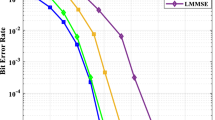Abstract
The PHY security has been the focus of the researchers since the day it was proposed. The researchers have mentioned many kinds of methods to prevent the eavesdropper from overhearing the confidential signal in different types of networks and environments. However, none of them have proposed a method which can be used in MIMO-OFDM. In this paper, we propose a new method to protect the confidential signal from the eavesdropper. We present a new antennas allocation scheme to make a full use of the CSI of the transmitter and helpers, and propose a double check scheme to distinguish the eavesdropper from helpers. At last, we use GA solve the optimization equation and gain the maximum of the secrecy capacity within limited power consumption. To the best of our knowledge, this is the first method of dealing with the eavesdropper in MIMO-OFDM, and both the schemes, including the antennas allocation scheme and the double check scheme, are the first of its kinds in this type of network environment.





Similar content being viewed by others
Notes
The secrecy capacity is defined as the maximum achievable transmission rate of confidential information from the transmitter to the receiver.
References
Akitaya, T., Asano, S., & Saba, T. (2014). Time-domain artificial noise generation technique using time-domain and frequency-domain processing for physical layer security in MIMO-OFDM systems. In 2014 IEEE international conference on communications workshops (ICC) (pp. 807–812).
Cepheli, O., & Kurt, G. (2013). Efficient PHY layer security in MIMO-OFDM: Spatiotemporal selective artificial noise. In 2013 IEEE 14th international symposium and workshops on a world of wireless, mobile and multimedia networks (WoWMoM) (pp. 1–6).
Csiszar, I., & Korner, J. (1978). Broadcast channels with confidential messages. IEEE Transactions on Information Theory, 24(3), 339–348.
Goel, S., & Negi, R. (2008). Guaranteeing secrecy using artificial noise. IEEE Transactions on Wireless Communications, 7(6), 2180–2189.
Huang, J., & Swindlehurst, A. (2010). Secure communications via cooperative jamming in two-hop relay systems. In 2010 IEEE on global telecommunications conference (GLOBECOM 2010) (pp. 1–5).
Huang, J., & Swindlehurst, A. (2011). Cooperative jamming for secure communications in MIMO relay networks. IEEE Transactions on Signal Processing, 59(10), 4871–4884.
Luo, S., Li, J., & Petropulu, A. (2013). Uncoordinated cooperative jamming for secret communications. IEEE Transactions on Information Forensics and Security, 8(7), 1081–1090.
Pei, Y., Liang, Y. C., Teh, K. C., & Li, K. H. (2011). Secure communication in multiantenna cognitive radio networks with imperfect channel state information. IEEE Transactions on Signal Processing, 59(4), 1683–1693.
Rodriguez, L. J., Tran, N. H., Duong, T. Q., Le-Ngoc, T., Elkashlan, M., & Shetty, S. (2015). Physical layer security in wireless cooperative relay networks: State of the art and beyond. IEEE Communications Magazine, 53(12), 32–39.
Shiu, Y. S., Chang, S. Y., Wu, H. C., Huang, S. H., & Chen, H. H. (2011). Physical layer security in wireless networks: A tutorial. IEEE Wireless Communications, 18(2), 66–74.
Wang, J., & Swindlehurst, A. (2009). Cooperative jamming in MIMO ad-hoc networks. In 2009 Conference record of the forty-third Asilomar conference on signals, systems and computers (pp. 1719–1723).
Wang, W., Chatterjee, M., & Kwiat, K. (2011). Collaborative jamming and collaborative defense in cognitive radio networks. In 2011 IEEE international symposium on a world of wireless, mobile and multimedia networks (WoWMoM) (pp. 1–6).
Wyner, A. (1975). The wire-tap channel. Bell Labs Technical Journal, 54(8), 1355–1387.
Acknowledgements
The authors would like to thank the support from the National Natural Science Foundation of China (Grant Nos. 61572070, 61272505, 61371069 and 61471028), the Fundamental Research Funds for the Central Universities (2015JBM016), the Specialized Research Fund for the Doctoral Program of Higher Education (Grant No. 20130009110015), and the financial support from China Scholarship Council.
Author information
Authors and Affiliations
Corresponding author
Appendix: Solution of \({\mathbf {v}}_i\)
Appendix: Solution of \({\mathbf {v}}_i\)
From Eq. (17), we can simplify the equation by decompose \({\mathbf {v}}_i\) as \({\mathbf {v}}_i={\mathbf {Bz}}\), where \({\mathbf {B}}\) satisfies the equation
One can note that \({\mathbf {B}}\) is a Hermitian matrix and \({\mathbf {BB}}={\mathbf {B}}\). Then \({\mathbf {B}}\) is a symmetric idempotent matrix. The optimization is equivalent to the following form,
To simplify the expression, we extract one CSI matrix as example. \({\mathbf {z}}\) shall be in the same direction of the diagonal vector of \(({\mathbf {D}}^{\dag }_{hei}{\mathbf {B}})^\dag\), where \(i=1,2,\ldots ,N\). So we can get the following equation,
Here, we propose a Lemma to deduce the equation one step further.
Lemma 1
To a diagonal matrix \({\mathbf {B}}\) and any non-zero matrix \(\mathbf {C}\),
According to the Lemma 1, Eq. (38) can be simplified as
Plugging \({\mathbf {B}}\) into Eq. (40), we can get Eq. (17).
Rights and permissions
About this article
Cite this article
Jing, T., Li, Z., Jiang, L. et al. Preventing Eavesdropper by Artificial Noise in MIMO-OFDM Systems. Wireless Pers Commun 99, 1103–1121 (2018). https://doi.org/10.1007/s11277-017-4808-9
Published:
Issue Date:
DOI: https://doi.org/10.1007/s11277-017-4808-9




